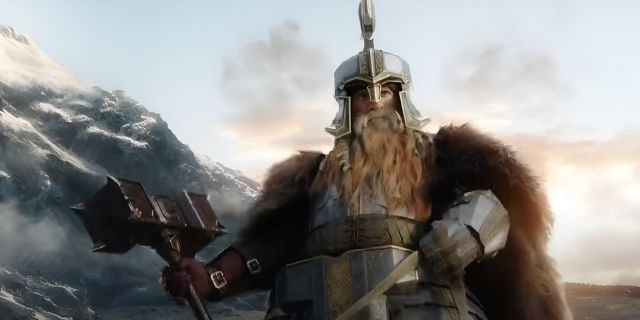Quick Links
- Who Rules Erebor After Thorin’s Death?
- Who Is Dáin Ironfoot?
- How Was Dáin II The Rightful Heir To Erebor?
In The Hobbit, Thorin Oakenshield, son of Thráin II, goes on a long quest to reclaim Erebor, the dwarven kingdom that has been in his family for generations. Although faced with many obstacles, Thorin is able to reclaim what is rightfully his with the help of Bilbo Baggins, Gandalf, and the rest of the dwarves in his company.
After years of exile from the Lonely Mountain, it was an extreme feat for Thorin to finally be able to rule from inside Erebor itself, something not even Thorin’s father was able to do because of the Sack of Erebor by Smaug before Thráin ever became king. Thorin ruled Erebor, if only for a short while, before he met his untimely death during the Battle of the Five Armies, leaving his kingdom without a ruler.
Although Thorin had traveled on his quest with a group of dwarves he was extremely close with, not many of them could say they had a strong claim, if any claim at all, to the Lonely Mountain. So who, then, ruled Erebor after Thorin’s death?
Who Rules Erebor After Thorin’s Death?

Throughout the course of The Hobbit trilogy, it’s learned that Thorin does in fact have heirs to his kingdom through his sister, Dís. Dís is the mother of two young dwarves in Thorin’s company, Fíli and Kíli. As Thorin’s nephews, the two were likely the only dwarves out of the 13 in Thorin’s company with any claim to Erebor.

Unfortunately, both Fíli and Kíli were killed during the Battle of the Five Armies, just like Thorin, leaving who would rule the Lonely Mountain up in the air.
However, in Thorin’s case, he had sent for Dáin II, or Dáin Ironfoot, to help him in battle after he had reclaimed the Lonely Mountain. After the Battle of the Five Armies, and the untimely death of Thorin and both his nephews, Dáin Ironfoot would be the one to inherit the Kingdom of Erebor.
Who Is Dáin Ironfoot?

Dáin Ironfoot, son of Náin, was the great-grandson of Dáin I, King Under the Mountain. His grandfather, Grór, was ruler of the Iron Hills. After Dáin’s father was killed during the Battle of Azanulbizar by the Orc chieftain Azog, the same orc who killed and beheaded Thorin’s grandfather, Dáin inherited the Iron Hills from his grandfather. Although The Hobbit film trilogy portrays things a little differently, in the book, Dáin is the dwarf who kills Azog, an extremely huge feat for a dwarf of his age at the time.
Dáin rules as the Lord of the Iron Hills, and later answers the call of Thorin for help to hold the Lonely Mountain after reclaiming it from the dragon Smaug. The two were close, so Dáin didn’t hesitate to answer the call, and swiftly marched his army of 500 soldiers, who were extremely strong when compared to dwarven standards, all the way to Erebor, giving Thorin an upper hand.
Dáin and his army helped Thorin hold the Lonely Mountain during the Battle of the Five Armies. And after the battle, Dáin would inherit the kingdom of Erebor since neither Thorin or his nephews would survive it. This made Dáin the Dwarven King of Durin’s Folk and the fifth King Under the Mountain, (the first of which to rule outside of the main line).
After the Battle of the Five Armies, Dáin went on to rule during what is considered a very peaceful time for dwarves, all the way up to the War of the Ring. It was during this time that Sauron offered the dwarves an alliance, and even offered to return some of the stolen dwarven rings of power in return, but Dáin refused knowing just how untrustworthy Sauron was. This led to the dwarves participating in a very long and brutal battle with Sauron’s allies during the War of the Ring, which they came out triumphant.
He died during the Battle of Dale being a true friend by defending the body of King Brand of Dale. At the time of his death, he was an extremely old dwarf, which Gandalf later makes note of upon hearing of this noble dwarf’s death.
I should call that a heavy loss, if it was not a wonder rather that in his great age he could still wield his axe as mightily as they say he did, standing over the body of King Brand before the gate of Erebor, until the darkness fell.
How Was Dáin II The Rightful Heir To Erebor?

Although Fíli and Kíli are Thorin’s nephews, it’s highly unlikely that either one of them would have become King Under the Mountain had they survived. It’s not that they don’t have any claim to the throne, because they do hold a very strong claim. However, they are related to Thorin through their mother, Dís.
As a woman, Dís unfortunately doesn’t have much of a claim to the throne of Erebor since dwarven succession prioritized children of male heirs. This means that any male relatives related to her and Thorin through their father would likely have a greater claim to the throne than her sons do. If no other male relatives existed, then Fíli, the older of the two, would have been able to inherit Erebor had he survived the war.
However, Dáin Ironfoot was actually related to Thorin through Thorin’s grandfather, Thrór. Dáin’s grandfather, Grór, was the brother of Thrór. This made the two dwarves cousins and both direct descendants of Dáin I, their great grandfather and King Under the Mountain, through male-only relatives. This gave Dáin a much stronger claim to the throne of Erebor in The Hobbit than either Fíli and Kíli, making him the rightful heir to the Lonely Mountain.











Leave a Reply